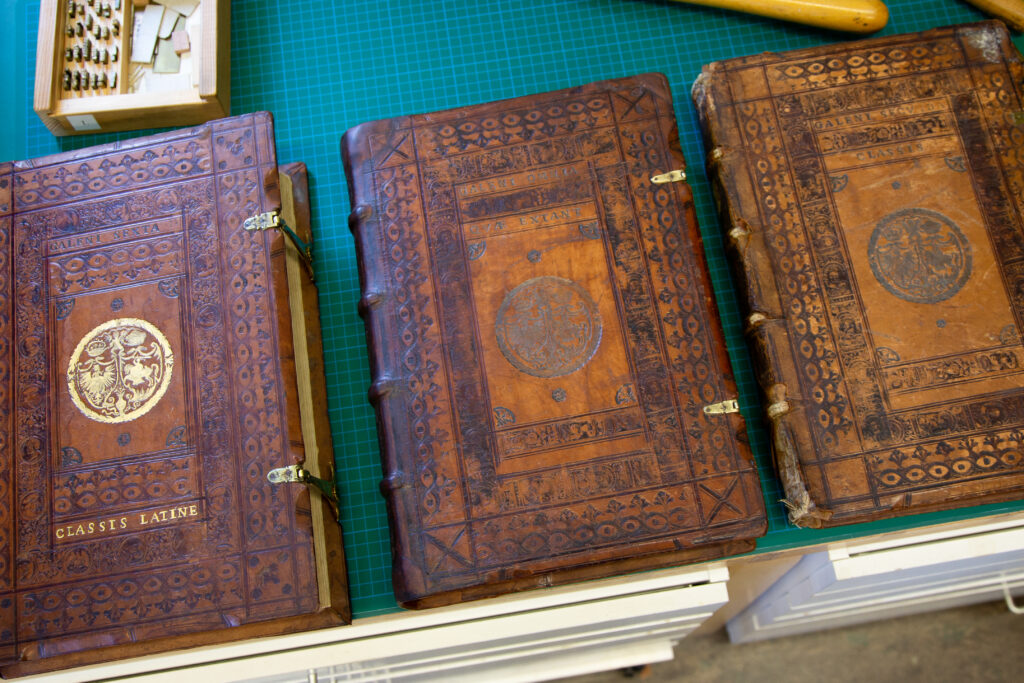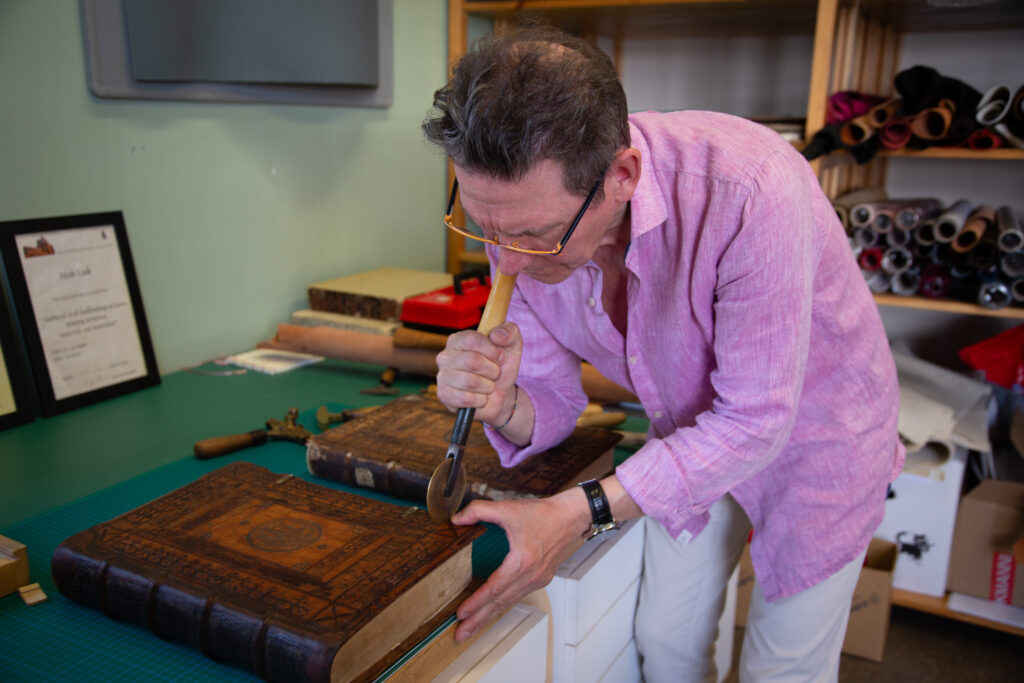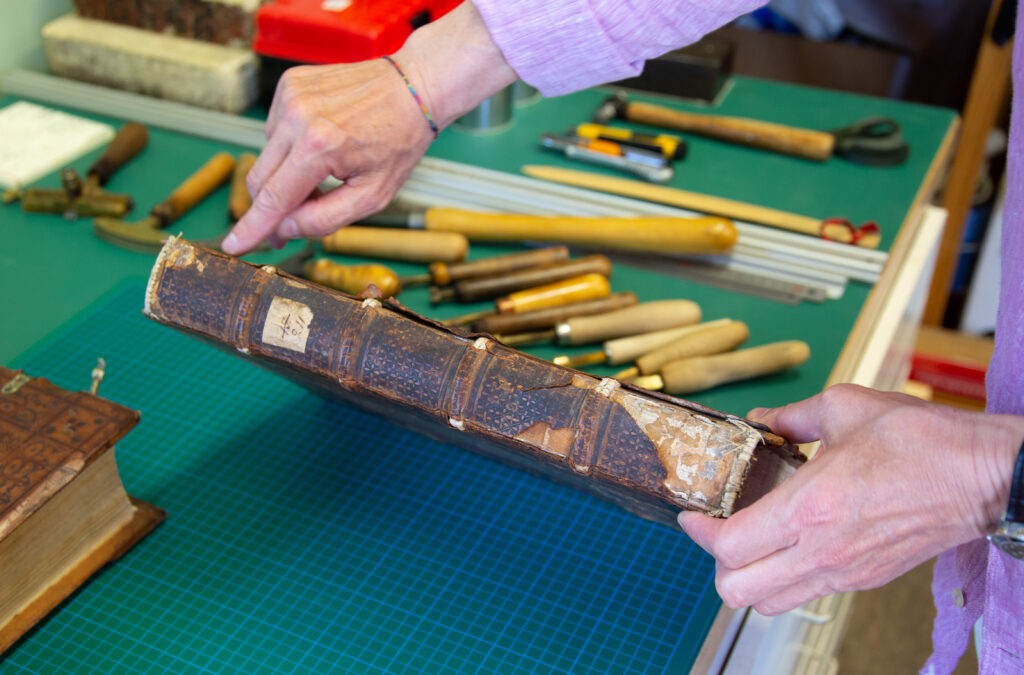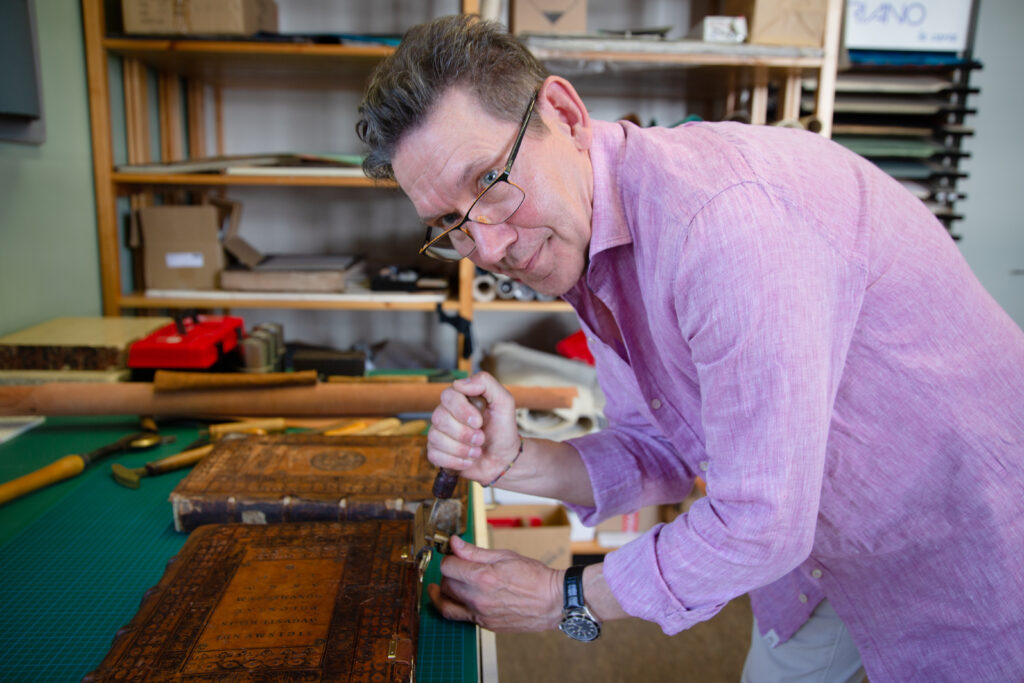20.9.2022
Renaissance treasures from Åbo Akademi University Library are exhibited at Turku Castle
Not all royalty at that time could even read. But for a Renaissance man like Sigismund, a well-stocked library was a way to show that he was keeping up with the times, and that he was rich. Three magnificent leatherbound volumes that belonged to the Polish king are being restored to their glory at Åbo Akademi University Library.
– I don’t know exactly what the book locks looked like. I have searched for ideas from contemporary Italian volumes, sanded and patinated the locks so that they look genuine, says Mait Luik who is a book conservator at Åbo Akademi University Library.
Mait Luik is in the process of preparing three volumes of Galen’s medical works, printed in Italy in the 1550s, for exhibition. He has cleaned them, carefully patched broken spines and corners and made new brass book locks.


The works are part of the Gadolin collection at Åbo Akademi University Library and are mostly locked away, accessible only to researchers and archivists. This autumn, the restored volumes will be exhibited at Turku Castle as part of an exhibition about the Renaissance and Catherine Jagiellon.
The volumes once belonged to the Polish king Sigismund II Augustus (1520–1572), who was Catherine Jagiellon’s brother.
– Books had a very high status among nobility and royalty at that time. Sigismund had upwards of 5,000 books in his library and had his own royal bookbinder, says Eva Costiander-Huldén, Senior Information Specialist at Åbo Akademi University Library.
– The king did not buy his books himself but hired emissaries, and probably never read these books himself either. Not all royalty at that time could even read. But for a Renaissance man like Sigismund, king of the great power of Poland at the time, a well-stocked library was a way to outwardly show that he was keeping up with the times, and that he was rich.
The three volumes are medical writings, written in Latin and printed in Venice in 1556. The text is attributed to Claudius Galen, one of the most influential physicians and medical writers of antiquity, and the foremost authority on medicine well into the 17th century.
– You could say that medical science developed a little more slowly at that time, says Eva Costiander-Huldén.
A distinct craft
The book covers are made of leather, decorated with blind embossing and a royal super ex libris with the coats of arms of Poland and Lithuania in gold. The text “SIGISMUNDI AUGUSTI REGIS POLONIAE MONUMENTUM 1563” on the back cover indicates the owner and date of binding.
– Having a book printed and bound at this time was an extremely expensive and time-consuming business that required a number of different craftsmen and professionals, from tanners to typesetters to printers to bookbinders. It could take over half a year to complete a work like this, says Mait Luik.
The customer would first buy the printed insert, i.e. all the pages of the book. Then they had a bookbinder bind the insert according to the customer’s wishes and budget. Royal volumes could even be decorated with precious stones.
What makes these volumes valuable is the provenance, their origin and history. They are also among the most beautiful volumes we have in the Gadolin Library.
The three Galen volumes in the Gadolin Library were likely bound by Sigismund’s court binders in Vilnius.
– The book industry back then was already very international. The insert was printed in Italy, but the paper was purchased from several places. Some pages have a watermark depicting a wild boar. It tells us that the paper came from a paper mill in Świdnica, Silesia, in present-day Poland. Another watermark depicting an anchor and a star tells us that part of the paper was made in Venice, says Mait Luik.
The paper is so-called rag paper, made from rags—simply old textile scraps. The rag paper has longer fibres than today’s cellulose paper, is very durable and has a neutral pH value. Many really important documents are still written on rag paper, explains Mait Luik.
– The 500-year-old pages in these books are as if they were made yesterday.
From war booty to professor’s bookshelf
How the volumes from the royal Polish library ended up in the Gadolin collection in Turku is not completely clear.
The Gadolin Library was the chemist and professor Johan Gadolin’s (1760–1852) private library. Several of the books in the collection belonged to his father, the professor and bishop Jakob Gadolin (1719–1802), and his father-in-law, the professor and bishop John Browall (1707–1755). The collection therefore includes the acquisitions of three generations of professors and is set of scientific works but also of more practical literature.
– It is likely that the three Galen volumes were part of the enormous war booty that the Swedes took from Eastern and Central Europe during the constant wars in the 17th century. Sweden was poor, situated on the periphery and needed cultural capital, and books had status and symbolic value for the Swedish court as well, says Eva Costiander-Huldén.


Johan Browallius probably had the opportunity at some point to buy the works in Sweden, perhaps because they were not old enough or new enough to be interesting to other book collectors.
– What makes these volumes valuable is precisely the provenance, their origin and history. They are also among the most beautiful volumes we have in the Gadolin Library. On the other hand, I might think that the seemingly inconspicuous, worn little books in the collection that deal with drainage, potato farming or liquor distilling and ordinary people, are more valuable in terms of content. But that depends on who you ask.
The Gadolin Library was included in the national register of UNESCO World Heritage Sites in 2017.
The exhibition The Princess’s Journey, about Catherine Jagiellon’s life and world opens in Turku Castle on November 2.
